India’s manufacturing economy is roaring. From foundries in Kolhapur to textile mills in Surat, the country’s factories are working overtime to meet
India’s manufacturing economy is roaring. From foundries in Kolhapur to textile mills in Surat, the country’s factories are working overtime to meet domestic and global demand – especially as the festive season triggers its annual production surge.
But behind the hum of progress, there’s a quieter crisis unfolding on factory floors.
In 2024 alone, over 400 Indian workers lost their lives to workplace accidents, with more than 850 seriously injured, according to IndustriALL Global Union. Over the last decade, government data shows that an average of 1,000 workers die in factory-related incidents every year under the Factories Act (Factly, 2023).
While these figures are troubling on their own, experts agree the actual numbers are likely much higher, given India’s vast informal and subcontracted workforce where safety lapses often go unreported.
A Systemic Challenge: Predictable, Yet Unprevented
Every major industrial accident leaves a trail of data – signals that, in hindsight, could have prevented the loss. Sudden temperature spikes, irregular pressure readings, abnormal machine vibrations, or chemical imbalance warnings are often detected hours before an incident.
And yet, traditional safety systems remain largely reactive. They record, report, and audit – but rarely predict.
A 2024 Business Standard analysis showed that while workplace injuries in India’s organized sector rose by 8.5% in FY23, high-consequence injuries (those causing long-term harm) increased by over 30%, even as fatalities slightly declined. The message is clear: injuries are happening earlier, faster, and more frequently – often because anomalies go unnoticed in real time.
Enter iotAR: Making Safety Intelligent
This is the challenge iotAR was built to solve.
At its core, iotAR is an industrial risk intelligence platform that brings AI, IoT, and real-time analytics into the heart of factory operations. It continuously scans machinery, ambient conditions, and human activity to detect early signs of trouble – long before they escalate into accidents or downtime.
“Most industrial accidents aren’t random – they’re patterns we failed to catch in time,” says Adam Poole, Founder of iotAR. “Our mission is to give every plant leader the ability to see risk before it happens.”
By integrating data from temperature sensors, vibration meters, emission monitors, and motion analytics, iotAR builds a digital safety layer that never sleeps. It alerts supervisors in real time, logs risk severity, and even learns over time to improve prediction accuracy.
From Safety to Sustainability
The impact goes far beyond accident prevention. iotAR helps manufacturers:
- Reduce unplanned downtime through predictive maintenance.
- Increase compliance readiness for global audits.
- Enhance workforce confidence and morale through visible, proactive safety.
In foundries, machining units, and chemical plants – environments where seconds can separate routine from disaster – these capabilities create not just safer operations, but more sustainable and efficient ones.
A Safer Future for India’s Factories
India’s path to becoming a $1 trillion manufacturing economy by 2030 depends not only on scale and speed but on safety and intelligence. Global OEMs increasingly evaluate suppliers not just on cost but on reliability, safety records, and sustainability practices.
“Safety isn’t just compliance – it’s a confidence driver,” says Adam Poole. “When you can guarantee uptime and safety, you don’t just make parts. You make trust.”
iotAR’s recent deployments across automotive and chemical plants have already shown measurable benefits – from fewer incidents during high-output months to improved productivity on the shop floor.
The Shift We Need
Ultimately, the promise of iotAR is cultural as much as technological. It encourages factories to move from compliance to consciousness – where safety isn’t a checklist, but a shared daily practice powered by data and foresight.
Because the future of manufacturing won’t just belong to those who produce more. It will belong to those who produce smarter, safer, and sustainably.


COMMENTS